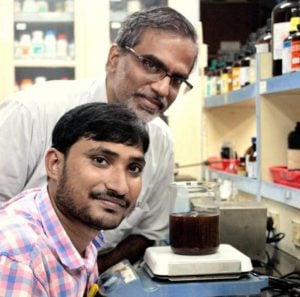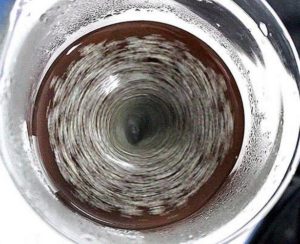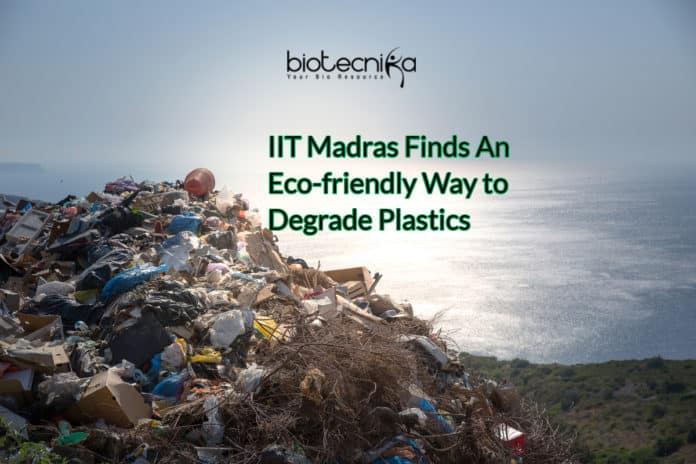An Eco-friendly Way to Degrade Plastics by Researchers from IIT Madras
This strategy can degrade several varieties of plastic – Teflon, polyethylene, polypropylene
About 3 years ago scientists from the Indian Institute of Technology (IIT) Madras observed silver slowly dissolving in a glucose solution when it was heated to 70 degrees C. Now, the research team has demonstrated an environment-friendly way to degrade the chemically inert and physically stable plastic fluoropolymer i.e, polytetrafluoroethylene (PTFE) of which Teflon is made. All that is required to degrade this fluoropolymer into molecules is a continuous stirring of it in water which contains 1,000 ppm glucose and also metal ions for about 15 days at 70 degrees C. This is an eco-friendly way to degrade plastics.

Using the same strategy, the research team led by T. Pradeep from the Department of Chemistry at IIT Madras was able to degrade the polypropylene too. The results of the study were published in the journal ACS Sustainable Chemistry & Engineering.
The research team used a magnetic stirrer coated with Teflon to continuously stirred for many days the water mixed with glucose in a beaker that contains a gold foil. Prof. Pradeep said that after a few days, the team observed something unusual. They found tiny fragments with bright red luminescence floating on the surface. In earlier studies, researchers found that gold, too, corrodes very slowly due to the presence of glucose. This phenomenon was observed when other sugars were also tested.

The initial intuition of the team that the bright red luminescent particles should be containing gold turned out to be correct. After all, compounds with gold carbon bonds showing red luminescence are well known. But to their surprise, besides gold, the team found that the tiny particles also contained fluorocarbon polymer. He said that they thought that Teflon impurities were being released due to mechanical action.
So the research team tested Teflon in different forms i.e, pellets, tapes, and plates. The team repeated the experiments using a Teflon beaker and also tried different metals too and still, they got the same results each time. The only difference was that the particles didn’t show bright red luminescence when copper, silver, and iron were used instead of gold.
The research team then got a clue that the PTFE polymer might be breaking down into molecules through a triboelectric degradation. And an electric potential is produced at the interface of Teflon and water when the polymer is continuously stirred in water, explained Prof. Pradeep when speaking about their eco-friendly way to degrade plastics.
When glucose is added to water, it first leaches out ions from the metal surface. And when the PTFE coated magnetic pellet is continuously rotated, the triboelectric charges get generated on the pellet. The PTFE gets negatively charged and the negative charge on the PTFE surface attracts the metal ions that have been leached out. Interaction between the metal ions and the PTFE results in metal-polymer bonding, causing the carbon-carbon bonds to destabilize which then eventually results in PTFEs degrading into small molecules.
In addition to this, no such degradation of PTFE was noticed in the absence of stirring, glucose and metal ions. Rate of degradation of PTFE gets reduced at room temperature.
Abhijit Nag from IIT Madras who is the first author of the paper said that the amount of triboelectric degradation happens depending on the amount of glucose that is dissolved in water. And as the amount of glucose in water increases more metal ions get leached that leads to more interaction between PTFE and metal ions. And as more metal ions bind to PTFE, there is enhanced PTFE degradation.
Prof. Pradeep added that the mass spectrometry signatures imply the presence of molecular fragments of PTFE polymer. The fragments seen floating on the water surfaces might be due to aggregation of the molecular fragments or even due to fragmentation of the long polymer.
The team working on an eco-friendly way to degrade plastics, have now tested it on polyethylene and polyethylene terephthalate (PET) and got very similar results. For a given concentration of dissolved glucose in water, the reaction is slow as the generation of triboelectric charge is less compared with PTFE, said Nag.
According to the research paper, similar chemistry can possibly lead to micro and nanoplastics in food during cooking as much modern cookware are coated with Teflon.
Prof. Pradeep explained that the Triboelectric degradation of PTFE, polypropylene and the other polymers might be occurring in nature in oceans where the metal ions are found in abundance and the waves provide a constant agitation. And this must be one of the ways by which the microplastics get generated, he added.
































